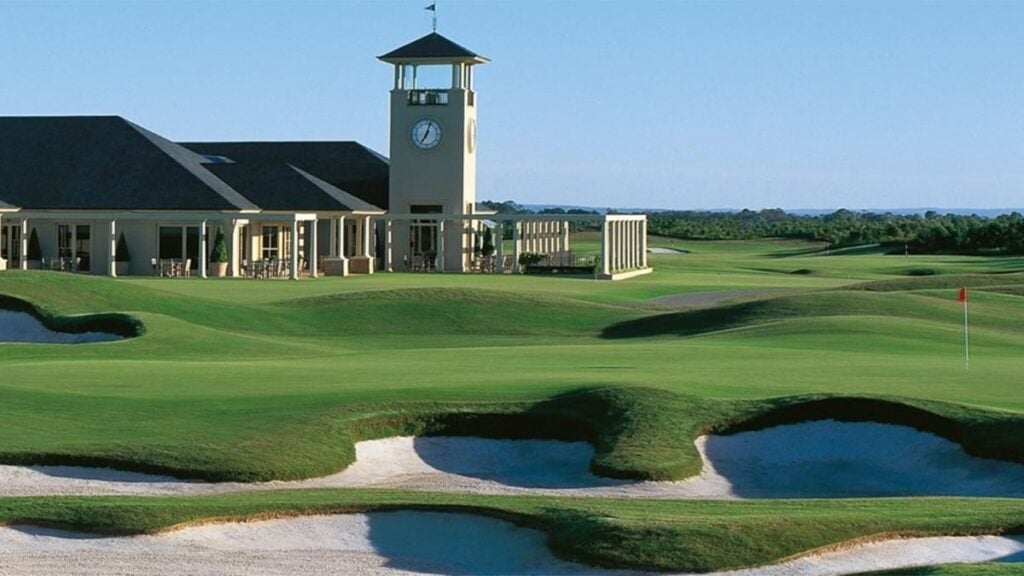The playing strategy and swing adjustments for driving on a hole that curves one way or the other require an assumption on my behalf. I have to believe you are capable of shaping shots with little difficulty. If you’re new to the game or always rely on the same shot shape, my advice for playing a dogleg is to stick with the shot you’re used to playing. Your goal is to hit the next one from the fairway, regardless of the fact that your shape might put you further away from the flagstick than if you hit a shot that curved with the hole.
OK, with that disclaimer out of the way, let’s talk about how to handle a dogleg left versus a dogleg right. And when I coach you on this topic, I’m assuming you swing right-handed, so lefties, adjust accordingly.
Dogleg left
To really get the ball way down the fairway on these holes, I recommend hitting a high draw, and you can get most of that done with your address position.
A few basics on the setup. If you were perfectly aligned for a straight ball – square clubface, body and aim in a fully neutral position – let’s consider that the baseline for the adjustments I’m about to walk you through. If you want to draw it, you have to shift that baseline to the right (remember, I’m talking to right-handed players here). That means the upper body, lower body, feet, everything shifts to the right of the target [below], which will in turn shift the swing path in the same direction, and that’s what creates more right-to-left curve.
/Baile%20driver%20address%20DTL%20draw.jpg.rend.hgtvcom.966.644.suffix/1751465849655.jpeg)
Photo: Adam Riding
Keep in mind that when you curve the shot, you don’t want too much curve or you risk missing the fairway to the left, which is often where you’ll find the most trouble. You really don’t have to make wholesale changes to what you normally do. If you want a little more curve on the shot, like your start line is the right elbow of the dogleg but you want it to finish on the left side of the fairway, you might put a little more forearm rotation into the through-swing. I call that a rolled release [below], which produces more face rotation. The more the driver’s face is closed in relation to its path at impact, the bigger the draw.
/Baile%20driver%20through-swing%20draw.jpg.rend.hgtvcom.966.644.suffix/1751465883615.jpeg)
Photo: Adam Riding
When you put it all together – the setup and the swing – this is what that driver draw looks like.
Dogleg right
If the high draw is my recommendation for skilled golfers playing a dogleg-left, then you probably guessed a low fade is what I think you should go with for a dogleg-right. Just like the draw, you can pre-set this shot mostly in the setup.
Starting with a neutral setup, just shift your shoulders, hips and feet to the left of the target [below]. This will allow the club to swing more on an out-to-in path and put some left-to-right curve on the ball. However, the moment you start shifting left, the ball’s orientation to your body moves up. And the more forward it is, the easier it is to hit a weak, ballooning fade – not a shot you want. So make sure the ball is aligned no further forward than your left heel.
/Baile%20driver%20address%20DTL%20fade.jpg.rend.hgtvcom.966.644.suffix/1751465851708.jpeg)
Photo: Adam Riding
For the fade swing, again keep it simple. Just think about how you release the clubface through impact. You don’t want the face rolling over excessively, as it needs to be open to your swing path to produce a left-to-right curve. Knowing that, the release should be less of a roll of the forearms and more of a “cornering” release, like a side-arm throw or a slap where the wrist releases as if you were skimming a stone [below].
/Baile%20driver%20through-swing%20FO.jpg.rend.hgtvcom.966.644.suffix/1751465885176.jpeg)
Photo: Adam Riding
That side-arm motion will put some pop into your fade so you get the ball out past the corner of the dogleg and have a clean shot into the green.
Jason Baile, one of Golf Digest’s 50 Best Teachers in America, is director of instruction at Jupiter Hills Club in Tequesta, Florida.



